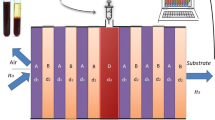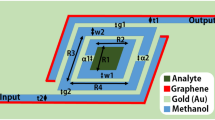Abstract
In this research, a novel configuration of 1D photonic crystal (PhC) is proposed for the detection of numerous elements present in human blood such as plasma, RBC, biotin, serum albumin. The proposed structure is envisaged with an alternate arrangement of CaF2, PtSe2 and ZnSe with a central defect layer, where the wall of the defect layer is separately coated with novel 2D materials like WS2, MoS2 and graphene to enhance the sensor performance. The well-known transfer matrix method (TMM) is employed to compute the transmission spectrum and absorption spectrum by infiltrating the defect layer with blood components. The cornerstone of this work is to observe the shift in the defect mode wavelength in the transmission spectrum. The geometrical parameters of the structure such as thickness of dielectric layers, defect layer, refractive index of dielectric layers and the number of period are judiciously optimized to realize effective sensor. The effect of variation in the defect layer thickness and angle of incidence on the transmission spectrum is thoroughly studied. Additionally, the number of layers of WS2, MoS2 and graphene are suitably optimized for design of high performance biosensor. Various sensing characteristics such as sensitivity, signal-to-noise ratio (SNR), quality factor (QF), figure of merit (FOM), resolution and detection limit (DL) are evaluated and compared for the proposed WS2, MoS2 and graphene based sensor configurations. Moreover, the simple structure, cost-effective fabrication methods and label-free detection of blood components make the proposed sensor a promising challenger for biosensing applications.














Similar content being viewed by others
Availability of data and material
Not applicable.
Code availability
Not applicable.
References
Abd El-Aziz, O.A., Elsayed, H.A., Sayed, M.I.: One-dimensional defective photonic crystals for the sensing and detection of protein. Appl Opt. 58(30), 8309–8315 (2019a)
Abd El-Aziz, O.A., Elsayed, H.A., Sayed, M.I.: One-dimensional defective photonic crystals for the sensing and detection of protein. Appl. Opt. 58(30), 8309–8315 (2019b)
Ahmed, A.M., Mehaney, A.: Ultra-high sensitive 1D porous silicon photonic crystal sensor based on the coupling of Tamm/Fano resonances in the mid-infrared region. Sci. Rep. 9, 6973 (2019). https://doi.org/10.1038/s41598-019-43440-y
Aly, A.H., Sayed, F.A.: THz cutoff frequency and multifunction Ti2Ba2Ca2Cu3O10/GaAs photonic bandgap materials. Int. J. Mod. Phys. B 34(10), 2050091 (2020). https://doi.org/10.1142/S0217979220500915
Aly, A.H., et al.: Biophotonic sensor for the detection of creatinine concentration in blood serum based on 1D photonic crystal. RSC Adv. 10, 31765–31772 (2020a)
Aly, H.A., et al.: Theoretical study of hybrid multifunctional one-dimensional photonic crystal as a flexible blood sugar sensor. Phys. Scr. 95, 035510 (2020b). https://doi.org/10.1088/1402-4896/ab53f5
Arunkumar, R., Suaganya, T., Robinson, S.: Design and analysis of 2D photonic crystal based biosensor to detect different blood components. Photonic Sens. 9, 69–77 (2019)
Boedecker, G., Henkel, C.: All-frequency effective medium theory of a photonic crystal. Opt. Express 11, 1590–1595 (2003). https://doi.org/10.1364/OE.11.001590
Bonaccorso, F., Sun, Z., Hasan, T., Ferrari, A.C.: Graphene photonics and optoelectronics. Nat. Photonics 4, 611–622 (2010)
Bouzidi, A., Bria, D., Falyouni, F., Akjouj, A., Lévêque, G., Azizi, M., Berkhli, H.: A biosensor based on one-dimensional photonic crystal for monitoring blood glycemia. J. Mater. Environ. Sci. 8(11), 3892–3896 (2017)
Boyd, R.W., Heebner, J.E.: Sensitive disk resonator photonic biosensor. Appl. Opt. 18(31), 15742–15747 (2001)
Chen, H.L., Lee, H.F., Chao, W.C., Hsieh, C.I., Ko, F.H.: Fabrication of autocloned photonic crystals by using high-density-plasma chemical vapor deposition. Vac. Sci. Technol. B 22, 3359 (2008)
Devashish, D., Ojambati, O.S., Hasan, S.B., van der Vegt, J.J.W., Vos, W.L.: Three-dimensional photonic band gap cavity with finite support: enhanced energy density and optical absorption. Phys. Rev. B 99, 075112 (2019). https://doi.org/10.1103/PhysRevB.99.075112
Elsayed, H.A.: A multi-channel optical filter by means of one dimensional n doped semiconductor dielectric photonic crystals. Mater. Chem. Phys. 216, 191–196 (2018)
Entezar, S.R., Saleki, Z., Madani, A.: Optical properties of a defective one-dimensional photonic crystal containing graphene nano layers. Phys. B 478, 122–126 (2015)
Falkovsky, L.A., Pershoguba, S.S.: Optical far-infrared properties of a graphene mono layer and multilayer. Phys. Rev. B 76(15), 153410 (2007). https://doi.org/10.1103/PhysRevB.76.153410
Gan, S., et al.: Ultra-sensitive refractive index sensors based on Bloch surface waves with transition metal dichalcogenides. IEEE Sens. J. 19(19), 8675–8680 (2019)
Geim, A.K.: Graphene: status and prospects. Science 324, 1530–1534 (2009)
Ghasemi, F., Entezar, S.R., Razi, S.: Terahertz tunable photonic crystal optical filter containing graphene and nonlinear electro-optic polymer. Laser Phys. 29, 056201 (2019). https://doi.org/10.1088/1555-6611/ab05c2
Guo, Y., et al.: Two-dimensional PtSe2 theoretically enhanced Goos–Hänchen shift sensitive plasmonic biosensors. Plasmonics 15, 1815–1826 (2020)
Han, L., et al.: Comprehensive study of SPR biosensor performance based on metal-ITO-graphene/TMDC hybrid multilayer. Plasmonics 14, 2021–2030 (2019)
Hattori, T.: Third-order nonlinearity enhancement in one-dimensional photonic crystal structures. Jpn. J. Appl. Phys. 41, 1349–1353 (2002)
Hemmatyar, O., Rahmani, B., Bagheri, A., Khavasi, A.: Phase resonance tuning and multi-band absorption via graphene-covered compound metallic gratings. IEEE J. Quantum Electron. 53, 1–10 (2017)
https://refractiveindex.info/?shelf=main&book=CaF2&page=Malitson.
https://refractiveindex.info/?shelf=main&book=ZnSe&page=Marple.
Ilinykh, V.A., Matyushkin, L.B.: Sol-gel fabrication of one-dimensional photonic crystals with predicted transmission spectra. J. Phys. Conf. Ser. 741, 012008 (2016). https://doi.org/10.1088/1742-6596/741/1/012008
Jahania, D., Raissi, B., Taati, F., Riahifar, R., Yaghmaee, M.S.: Optical properties of fluidic defect states in one-dimensional graphene-based photonic crystal biosensors: visible and infrared Hall regime sensing. Eur. Phys. J. plus. 135, 160 (2020). https://doi.org/10.1140/epjp/s13360-019-00056-5
Janisch, C., et al.: Extraordinary second harmonic generation in tungsten disulfide monolayers. Sci. Rep. 4(1), 5530 (2015). https://doi.org/10.1038/srep05530
Jia, Y., Li, Z., Wang, H., Saeed, M., Cai, H.: Sensitivity enhancement of a surface plasmon resonance sensor with platinum diselenide. Sensors 20(1), 131 (2020)
John, S.: Strong localization of photons in certain disordered dielectric superlattices. Phys. Rev. Lett. 58, 2486–2489 (1987)
Keshavarz, A., Zangenehzadeh, S., Hatef, A.: Optimization of surface plasmon resonance-based biosensors for monitoring hemoglobin levels in human blood. Appl. Nanosci. 10, 1465–1474 (2020)
Kravets, V.G., et al.: Ellipsometry and optical spectroscopy of low-dimensional family TMDs. Semicond. Phys. Quantum Electron. Optoelectron. 20(3), 284–296 (2017)
Kukkar, M., Sharma, A., Kumar, P., Kim, K.H., Deep, A.: Application of MoS2 modified screen printed electrodes for highly sensitive detection of bovineserum albumin. Anal. Chim. Acta 939, 101–107 (2016)
Lin, C., Chen, S.: Design of high-performance Au-Ag-dielectric graphene based surface plasmon resonance biosensors using genetic algorithm. J. Appl. Phys. 125, 113101 (2019). https://doi.org/10.1063/1.5066354
Liu, X., et al.: Enhanced X-ray photon response in solution-synthesized CsPbBr3 nanoparticles wrapped by reduced graphene oxide. Sol. Energy Mater. Sol. Cells 187, 249–254 (2018)
Mittal, V., et al.: Optical quality ZnSe films and low loss waveguides on Si substrates for mid-infrared applications. Opt. Mater. Express 7(3), 712–725 (2017)
Mohammed, N.A., et al.: High-sensitivity ultra-quality factor and remarkable compact blood components biomedical sensor based on nanocavity coupled photonic crystal. Results Phys. 14, 102478 (2019). https://doi.org/10.1016/j.rinp.2019.102478
Nouman, W.M., Abd El-Ghany, S.E., Sallam, S.M., Dawood, A.F., Aly, A.H.: Biophotonic sensor for rapid detection of brain lesions using 1D photonic crystal. Opt. Quant. Electron. 52, 287 (2020). https://doi.org/10.1007/s11082-020-02409-2
Panda, A., Devi, P.P.: Photonic crystal biosensor for refractive index based cancerous cell detection. Opt. Fiber Technol. 54, 102123 (2020). https://doi.org/10.1016/j.yofte.2019.102123
Panda, A., Pukhrambam, P.D.: Investigation of defect based 1D photonic crystal structure for real-time detection of waterborne bacteria. Phys. B 607(3), 412854 (2021). https://doi.org/10.1016/j.physb.2021.412854
Panda, A., Sarkar, P., Palai, G.: Research on SAD-PRD losses in semiconductor waveguide for application in photonic integrated circuits. Optik 154, 748–754 (2018)
Panda, A., Pukhrambam, P.D., Keiser, G.: Realization of sucrose sensor using 1D photonic crystal structure vis-à-vis band gap analysis. Microsyst. Technol. 27, 833–842 (2021)
Qi, H., Wang, L., Sun, J., Long, Y., Hu, P., Liu, F., He, X.: Production methods of vander waals hetero structures based on transition metal dichalcogenides. Curr. Comput.-Aided Drug Des. 8(1), 35 (2018). https://doi.org/10.3390/cryst8010035
Schürmann, U., Takele, H., Zaporojtchenko, V., Faupel, F.: Optical and electrical properties of polymer metal nanocomposites prepared by magnetron co-sputtering. Thin Solid Films 515, 801–804 (2006)
Shaban, S.M., Mehaney, A., Aly, A.H.: Determination of 1-propanol, ethanol and methanol concentrations in water based on 1D phoxonic crystal sensor. Appl. Opt. 59(13), 3878–3885 (2020)
Sharma, P., et al.: Design and simulation of photonic crystal based biosensor for detection of different blood components. In: 2014 IEEE Region 10 Symposium, Kuala Lumpur, pp. 171–176 (2014). https://doi.org/10.1109/TENCONSpring.2014.6863019
Shi, B., Jiang, Z.M., Wang, X.: Defective photonic crystals with greatly enhanced second-harmonic generation. Opt. Lett. 26, 1194–1196 (2001)
Wang, H., Yan, K.P., Xie, J., Duan, M.: Fabrication of ZnO colloidal photonic crystal by spin-coating method. Mater. Sci. Semicond. Process. 11(2), 44–47 (2008)
Wang, Y., et al.: Monolayer PtSe2, a new semiconducting transition-metal dichalcogenide, epitaxially grown by direct selenization of Pt. Nano Lett. 15, 4013–4018 (2015)
Wei, J., et al.: Enhanced performance of light-controlled conductive switching in hybrid cuprous oxide/reduced graphene oxide (Cu2O/rGO) nanocomposites. Opt. Lett. 42(5), 911–914 (2017)
White, I.M., Fan, X.: On the performance quantification of resonant refractive index sensors. Opt. Express 16(2), 1020–1028 (2008)
Wolf, D.J., Zitelli, J.A.: Surgical margins for basal cell carcinoma. Arch. Dermatol. 123(3), 340344 (1987). https://doi.org/10.7759/cureus.9211
Yablanovitch, E.: Inhibited spontaneous emission in solid state physics and electronics. Phys. Rev. Lett. 58, 2059–2062 (1987)
Yuan, L., Huang, L.: Exciton dynamics and annihilation in WS2 2D semiconductors. Nanoscale 7, 7402–7408 (2015)
Zahid, M.A., et al.: Optical properties of CaF2 thin film deposited on borosilicate glass and its electrical performance in PV module applications. Appl. Sci. 10, 5647 (2020). https://doi.org/10.3390/app10165647
Zang, Z., et al.: Tunable photoluminescence of water-soluble AgInZnS–graphene oxide (GO) nanocomposites and their application in-vivo bioimaging. Sens. Actuators B Chem. 252, 1179–1186 (2017)
Zeng, C., Luo, C., Hao, L., Xie, Y.: The research on magnetic tunable characteristics of photonic crystal defect localized modes with a defect layer of nanoparticle. Chin. Opt. Lett. 12, 11602 (2014). https://doi.org/10.3788/COL201412.S11602
Zhu, B., Chen, X., Cui, X.: Exciton binding energy of monolayer WS2. Sci. Rep. 5, 9218 (2015). https://doi.org/10.1038/srep09218
Funding
There is no funding granted for the preparation of this manuscript.
Author information
Authors and Affiliations
Contributions
AP: Conceptualization, Methodology, Software, Data collection, Visualization, Investigation, Writing—Original draft preparation. PDP: Supervision, Writing—Reviewing and Editing.
Corresponding author
Ethics declarations
Conflicts of interest
There is no conflict of interest.
Additional information
Publisher's Note
Springer Nature remains neutral with regard to jurisdictional claims in published maps and institutional affiliations.
Rights and permissions
About this article
Cite this article
Panda, A., Pukhrambam, P.D. A theoretical proposal of high performance blood components biosensor based on defective 1D photonic crystal employing WS2, MoS2 and graphene. Opt Quant Electron 53, 357 (2021). https://doi.org/10.1007/s11082-021-03012-9
Received:
Accepted:
Published:
DOI: https://doi.org/10.1007/s11082-021-03012-9




